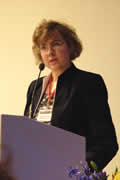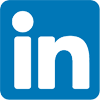WCE2005: Patients and scientists: essential partners in breakthrough research
WCE2005 Seminar on Best on Practice in Endometriosis:
How support groups can and have driven research forward including how they have been instrumental in raising vital financing.
By Mary Lou Ballweg
On January 14, 1980, eight women with endometriosis (endo) met in Milwaukee, Wisconsin, USA. We did not know at the time that we were the first support group for women with endo ever.
We did know that we were all struggling with a mysterious disease, without answers, with a lot of pain, and a lot of social and emotional issues. We said, “Let’s get a doctor in to answer our questions about this disease.”
At the next meeting, 21 women peppered the doctor with questions. He was honest in noting that for almost all of our questions there were no answers. So we said, “We’ll get the answers!”
Data demolishes myths
We immediately set to work – all volunteers at this point as it would be for the next 2½ years – developing a questionnaire, distributing it across the USA and Canada and coding and analysing the data. By fall, we already had more data than had ever been gathered on endo. We used what we were learning from our data and from hundreds of patient stories to inform our literature and demolish myths:
- Pain, not infertility, is the primary symptom
- Diagnosis is often delayed, up to 10 years
- Endo is often debilitating, not a minor problem to disregard
- Endo often has an early onset, as early as pre-teen, and is not due to delayed childbearing
- Pregnancy, though often recommended as a solution, is not a cure
- Danazol, then advertised to “melt away” the disease, is not, in fact, a cure.
Another part of what we learned was to be an important theme through our 25 years: namely, that there is a pattern of immune dysfunction in women with endo and their families. This was a new idea in 1980. The data reinforced the importance of truly hearing, and making the world hear, the stories of patients – either directly or through the statistics. As one scientist who worked with us stated, “Statistics are people with the tears wiped away.” Endometriosis – as any disease – starts with, and in, the patient.
By late 1980, we had more data than we could manage with volunteers. We linked up with Karen Lamb RN PhD and the Department of Preventive Medicine at the Medical College of Wisconsin. With her help, as well as medical students and volunteers (three members each put in more than 1,000 hours!), we completed coding and began publishing. We have continued publishing our data in medical journals and textbooks, at research conferences (including the IV World Congress in Brazil and the VI World Congress in Quebec) and in Endometriosis Association literature.
Some of our groups worldwide have also formed registries with our guidance, which have helped establish credibility and understanding in their countries. The Japan Endometriosis Association (JEMA) garnered attention from the Japanese Health Ministry with their registry. After our breakthrough dioxin research, JEMA, through its connections with the Health Ministry, was able to help EA Advisor Osamu Tsutsumi MD PhD obtain a US$6 million grant to study how to remove dioxins from the body. Thus, patient links create credibility and leverage which lead to further funding.
Finally, in perhaps the ultimate vote of confidence, we have worked hand-in-hand, side-by-side, with the National Institutes of Health (NIH) with this data. The first publication from that collaboration was our groundbreaking study on the link between endo and six autoimmune diseases, published in Human Reproduction, and receiving international press attention.
Funding – it’s all about partnership and synergy
How did we fund our early research? Because the Endometriosis Association always laid out a synergy of three programs – support, education, research – our members always supported research. They could see that our research provided valuable information to help them individually and to educate about the disease. Likewise, their experiences contributed to research. Then, as now, women with endo are involved in research through completion of surveys, sharing their experiences, donation of endometrial tissues, participation in clinical trials, and donation of funds. This organisational “investment” leveraged other contributions such as the time, computers, and expertise from the Medical College of Wisconsin.
Some would ask why we didn’t go to the government for funding. The NIH had put out a Request for Proposals on endo and had received none! A few years later, we were able to push funding for endo research through Congress. This time, far more proposals were received than could be funded. Clearly, we and others had changed the perception of endo as a disease worth studying. Ultimately, however, we concluded we were able to achieve better results in partnership with government and others, or in our own programs. As Kevin Osteen PhD, Director, Endometriosis Association Research Program at Vanderbilt University School of Medicine, says, “Government funding can be sporadic and is often quite restrictive, allowing only limited thinking outside the box.”
We do continue to work with government in a number of ways, including testimony before Congress and other agencies. One of these, before an influential US Senate committee, led to funding for the first NIH conference on endo with myself as keynote speaker. Recently, while serving on an NIH evaluation panel for 15 research centres, the question came up on why the endo-related focus group had been so successful. It became clear that the partnerships and networking facilitated by the Endometriosis Association had infiltrated across our field in North America, leveraging into greater productivity for everyone!
Private funding and cooperative agreements can be extremely productive, as seen in our partnerships with Dartmouth Medical College and Vanderbilt. We first established the Tracy H Dickinson Research Chair at Dartmouth in 1994 with Sherry Rier PhD. Meanwhile, Vanderbilt asked if we would set up a program with them and committed US$2 million and extensive laboratory space to the program. We worked out a joint vision, which included the involvement of patients, via the Endometriosis Association, in the research process. We also required that at least one scientist in the multidisciplinary team be from outside the USA and Canada due to our firm belief that we will solve the puzzles of endo faster if we bring cross-cultural thinking to bear on the problem. We also wanted to train young investigators who could continue research in their home countries. As Dr Osteen is fond of saying, “The Association’s money is not the most money (our Vanderbilt program receives money from many different sources including the NIH), but it is the best money…. Not only has the Endometriosis Association provided a means for bringing in young, enthusiastic scientists, but it also gives us the latitude to go after novel avenues of research.”
We are currently searching for the right situation to establish a clinical research program to complement our primarily basic science program at Vanderbilt (and beginning a new US$15 million Millennium Campaign for the Cure to help fund it). Attributes we hope to find include a large metropolitan area with a large and diverse patient base, a country with a strong Endometriosis Association group to provide the ongoing patient involvement and insights essential to real breakthroughs, EA Advisors or clinicians of high calibre, a visionary clinical/scientific leader, multidisciplinary practitioners, and strong institutional support.
Another funding/partnership mechanism is our Open Research Fund, which provides support to 20 scientific projects in six countries (USA, Canada, England, Scotland, Sweden, and Belgium). Researchers from anywhere in the world can apply to this fund, which has as its purpose to:
- promote new ideas,
- attract new investigators to endometriosis research,
- supply start-up funds for pilot projects leading to major funding from government and other sources.
Partnership and synergy = results
Two major breakthroughs illustrate the power of partnership and synergy in science. In 1992, we made a major breakthrough with the discovery that dioxin, an extremely toxic, cancer-causing chemical, could cause endo in rhesus monkeys. We and others have since expanded that research, including studies that show the not-surprising risk for six cancers in those with endo. These discoveries were only possible because our earlier work had alerted us to the unusual immune dysfunction pattern we were seeing; because we already had physicians and scientists aboard, and patients ready to respond to these discoveries; and because we had a research fund for emergency action.
The second example is one that you will hear more about at this conference on Thursday at noon. While at Dartmouth, Dr Rier introduced Grant Yeaman PhD, a mucosal immunologist, to our work. Dr Yeaman had some research ideas with possible applicability to endo. No one had been willing to fund it, but the moment I read his proposal, I saw that it related to the dysbiosis and other problems consistently reported by women with endo in their stories and in our data. With our support, Dr Yeaman discovered a unique marker in the blood of women with endo, which led to the development of a biotech company, the ability to diagnose endo with a blood test, and to potentially treat it in a totally new way. Partnership and synergy provide a win-win for everyone.
We are more than willing to help other patient groups, scientific groups, and clinicians with research or clinical programs on endo and related diseases. The more we share, the more we all advance. As our slogan says, “Together we make a difference.”
Additional presentations
» Best practice in endometriosis: working together!
» They hear, but are they listening?
» Implementing specialised support programmes in hospitals








